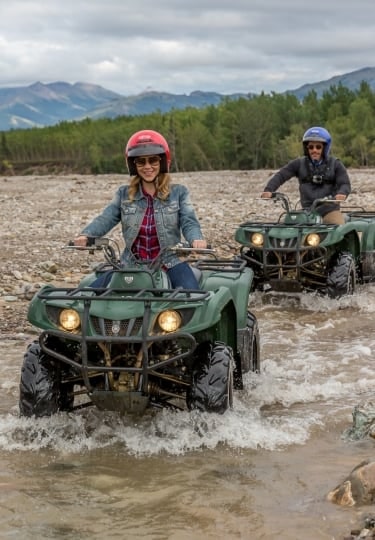When contemplating your “must do in Alaska” bucket list, bear in mind that there is no place on Earth like the 49th state. Alaskans like to call their home the Last Frontier, a phrase that still fits. After all, this is a state more than twice the size of Texas, but with less than a million residents.
Much of the land is all but untouched by humans and instead inhabited by an incredible array of wildlife. This is one of the few places where you can see humpback whales breaching near calving glaciers, or bald eagles hunting wild salmon.
The Alaskans who do live here tend to embody the fiercely unconventional, pioneer spirit of their Gold Rush-era prospector predecessors. This has long been a place where people have chosen to live according to their own rules, in some cases off the grid altogether. Travelers here will find warm hospitality, avant-garde art, and an infectious sense of adventure.
From seeing the Northern Lights to flying over the Arctic Circle, here are just a few of the must-see in Alaska experiences to plan.
Go Dog Sledding in Seward
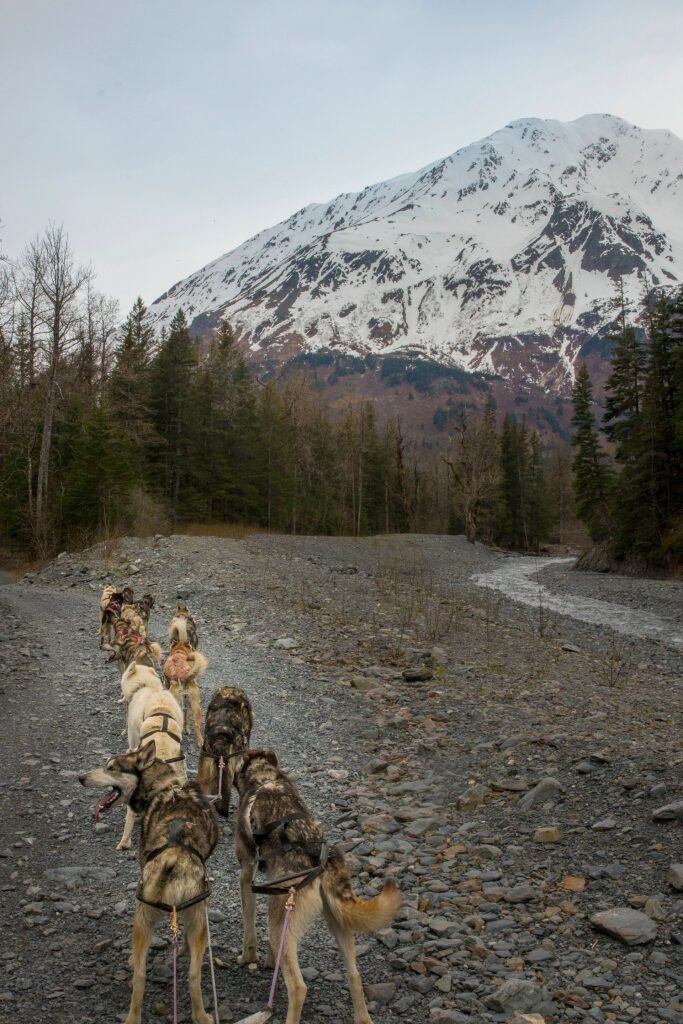
Dog sledding in Seward
In January 1925, a diphtheria outbreak was sweeping through Nome, Alaska, threatening the lives of all the local inhabitants. The frigid winter conditions rendered many forms of transportation treacherous or downright impossible.
The outlook was grim until a team of brave dog sledders traveled hundreds of miles carrying diphtheria antitoxin, a life-saving serum.
Almost a full century later, locals in Alaska still commemorate this courageous event with the Iditarod Sled Dog Race. Each year, teams of mushers zoom 1,000 miles over snowy terrain with their trained Alaskan malamutes, Samoyeds, and Siberian huskies.
Although technology may have advanced since the 1920s, dog racing in Alaska is much more than a sport. National park rangers often use teams of dogs to reach off-road spots in winter.
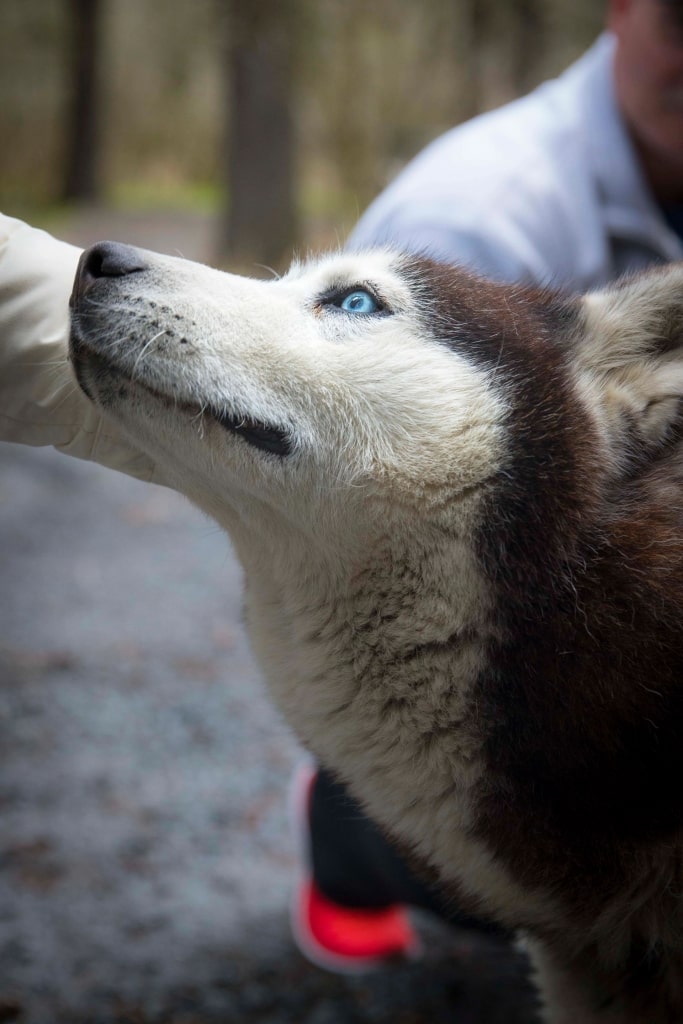
Dog sledding in Seward
Whether you’re a dog parent or simply an animal lover, it’s hard to think of a better way to spend an afternoon than hanging with these charismatic canines.
In the coastal town of Seward, visitors can tour the racing kennels and snuggle up to puppies. Afterward, you’ll board a custom wheeled sled for a two-mile ride from Seavey Homestead to Resurrection Mountain.
Read: Where to Go Dog Sledding in Alaska
Get Your Heart Racing on the World’s Largest ZipRider
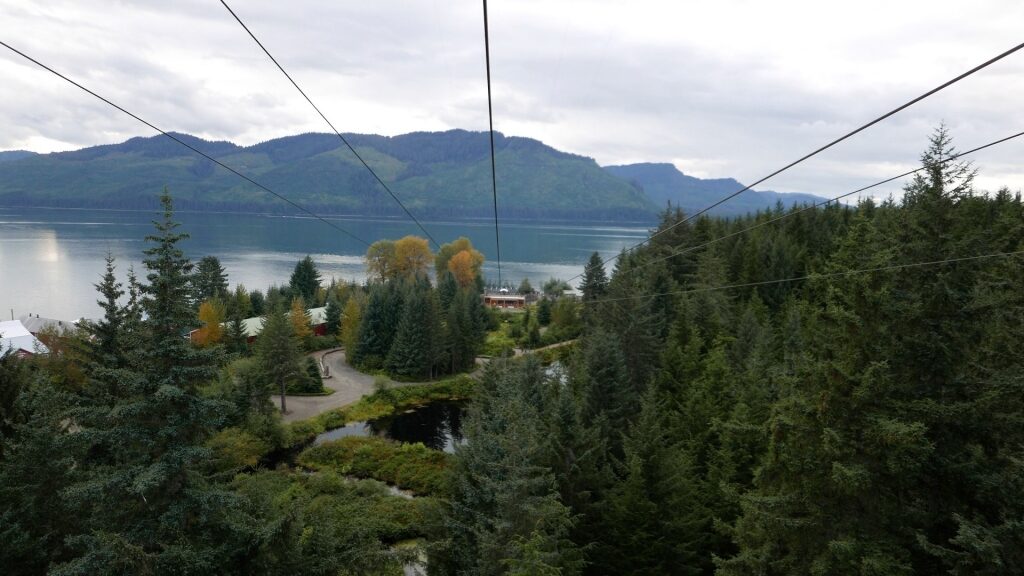
ZipRider in Icy Strait Point Photo by Werner Bayer on Flickr, licensed under CC0 1.0
If you’re the kind of person who instinctively heads straight for the tallest, fastest, most terrifying roller coaster at an amusement park, the ZipRider at Icy Strait Point should be right up there on you “must do in Alaska” list.
But even if you’re not a hardcore adrenaline-junkie, it just might be, too. Since groups of six can tackle this Alaskan adventure together, it makes for a great family bonding activity.
Situated in Icy Strait Point, this ZipRider is the biggest on the planet, featuring six 5,330-foot lines. Over the course of the ride, travelers plummet 1,330 feet at speeds of up to 60 miles per hour.
Taking the initial plunge off the first platform is admittedly daunting and may challenge even the most steadfast of nerves.
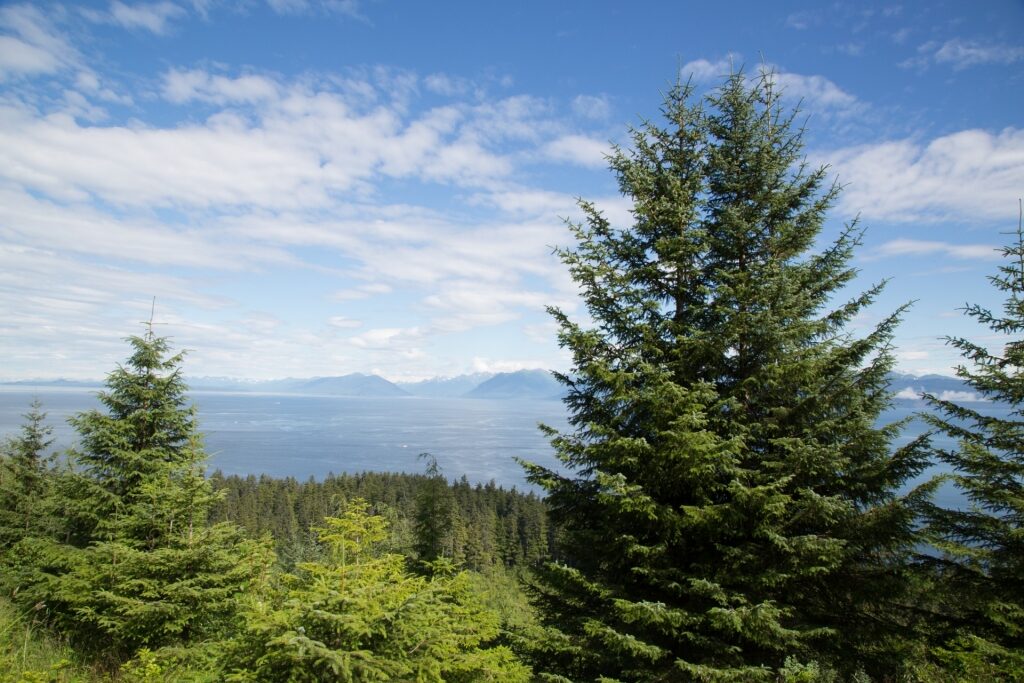
Icy Strait Point
Once you’re whizzing 300 feet over the temperate rainforest canopy, however, the ride is pure pleasure. It helps that the scenery is nothing short of spectacular. Keep an eye out for the icy peaks of the Fairweather Range in Glacier National Park in the distance.
While the ZipRider itself is obviously the high point, the journey to get there is an adventure in and of itself.
Drivers keep the bus ride from Hoonah interesting with all sorts of anecdotes and informational tidbits about the area. Take a window seat if you can; bears and other large mammals have a tendency to wander through the area.
Read: Best Zip Lines in the World
Go Whale Watching in Point Adolphus, Icy Strait
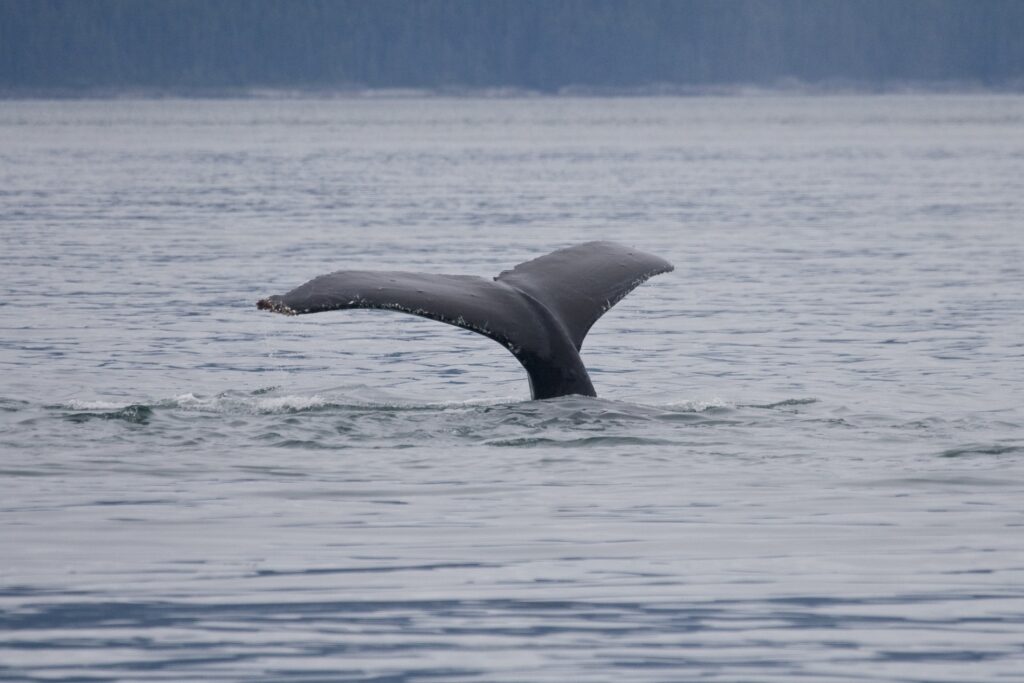
Humpback whale in Point Adolphus, Icy Strait Point
A warning: whale watching in Alaska may ruin you for doing it just about anywhere else. Whereas in some places, a stray tail fin sighting may be cause for celebration, Alaskan waters are teeming with marine life.
Among the many possible places to see cetaceans, Point Adolphus in Glacier Bay National Park ranks among the very best. These nutrient-dense waters toward the southern tip of Icy Strait draw large marine mammals of all kinds.
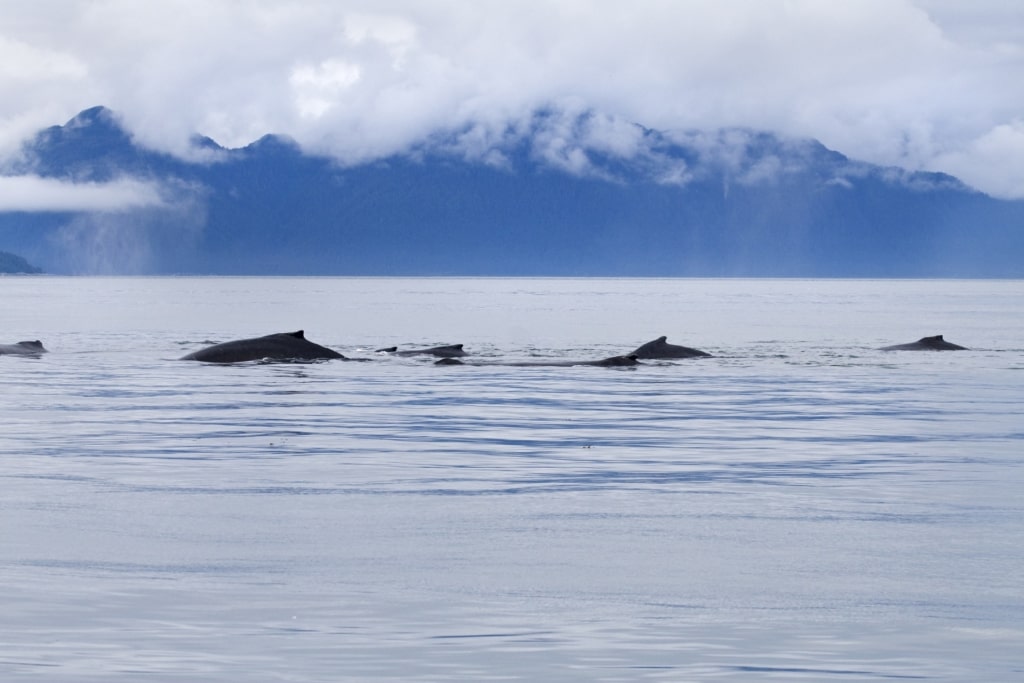
Humpback whale in Point Adolphus, Icy Strait Point
Each year, humpback whales migrate more than 10,000 miles from the warm waters of Hawaii in the winter to Alaska in the summer. Although these majestic giants were once critically endangered, more than 20,000 now swim here. As a result, this is a terrific place to watch humpback calves breaching and adults flashing their tails.
Travelers can expect to see plenty of other species on a whale-watching expedition here. Pods of both resident and transient orcas can often be spotted hunting here. Dall’s porpoises have a tendency to leap alongside boats and play the wake.
Read: How to Spot Marine Mammals From a Cruise Ship
Try a Traditional Alaskan Salmon Bake in Juneau
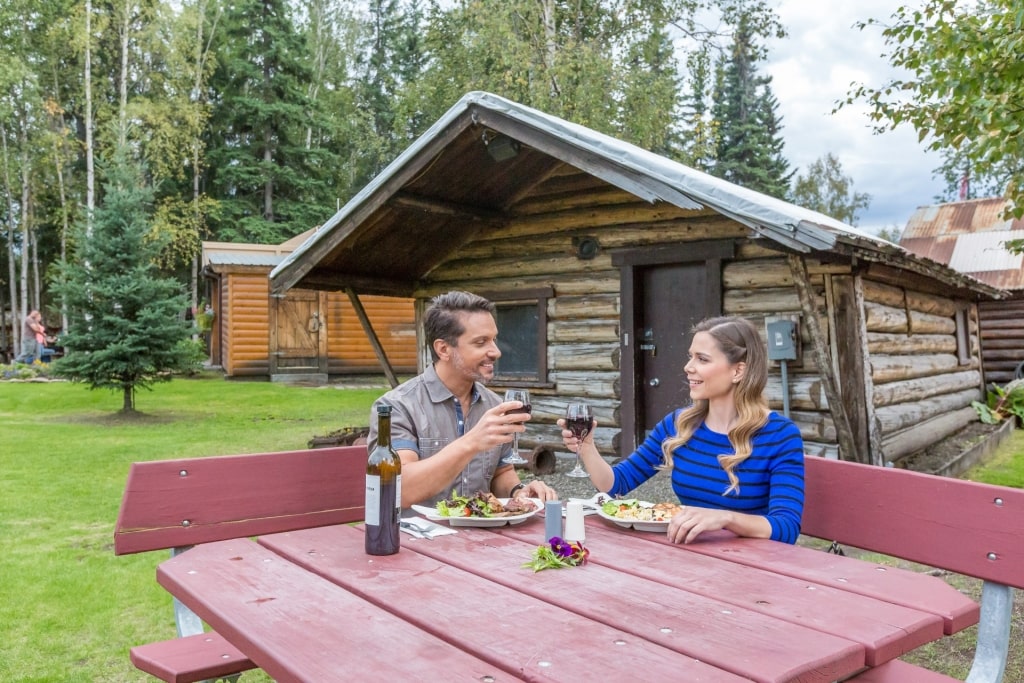
Alaskan salmon bake, Juneau
Wild salmon have been central to the Alaskan way of life for thousands of years. As a part of the local ecosystem, these fish are crucial. They provide a primary source of nutrition for everything from grizzly bears to bald eagles.
Indigenous Alaskan nations trapped and preserved salmon for generations before European colonists arrived. And when prospectors swarmed the state in a frenzied search for gold, wild salmon were a main source of sustenance.
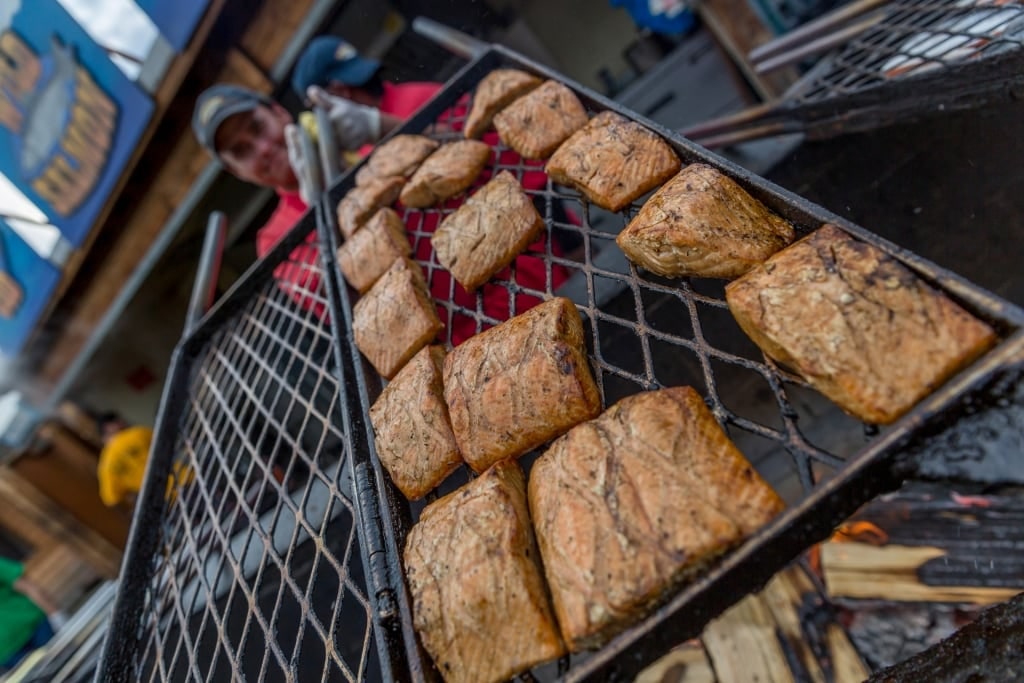
Alaskan salmon bake, Juneau
Today, Alaskan salmon are prized throughout the world for their rich, fatty, exceptionally flavorful meat. It’s also a rare success story when it comes to seafood sustainability. Thanks to decades of careful population management, wild Alaskan salmon is a treat travelers can enjoy with a clean conscience.
For a uniquely Alaskan experience, try an Alaskan salmon bake in Juneau. Traditionally, salmon bakes are community affairs, much like a Midwestern fish fry. The word “bake” is a bit of a misnomer, as the fish is actually slow-roasted over a live alderwood fire.
Visitors have feasted on Gold Creek Salmon Bakes in the temperate rainforest just outside Juneau for more than 30 years. Along the way to your meal, you’ll see a historic gold mine and hear tales of the region. The salmon bake includes a full spread with cornbread, potatoes, wild rice, and baked beans.
Learn All About Sea Creatures in Seward
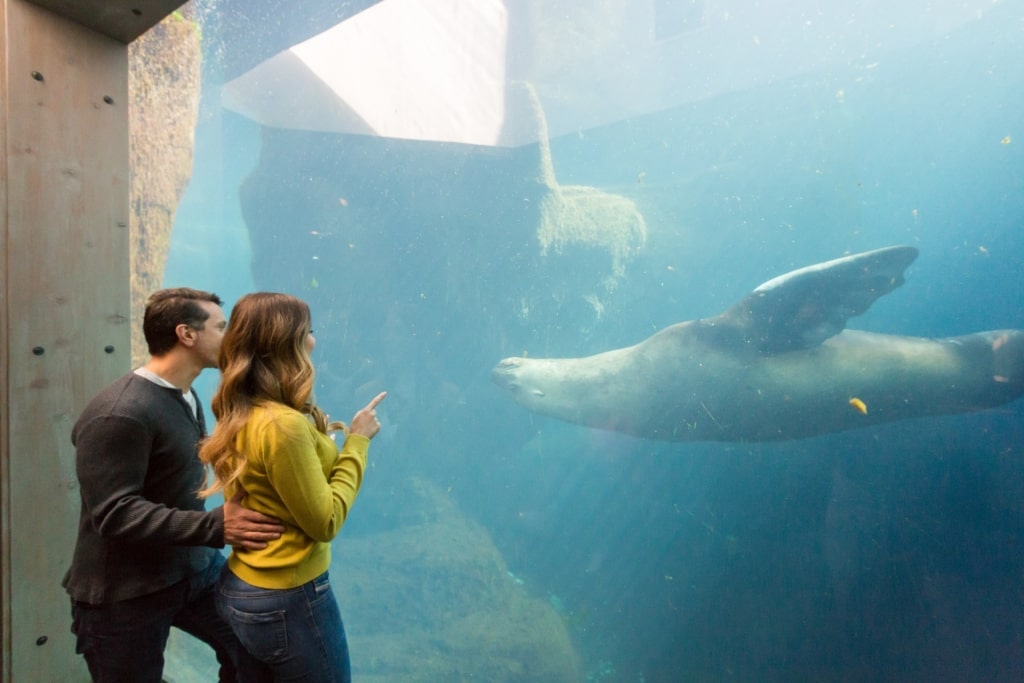
Alaska SeaLife Center
For a chance to meet adorable sea otter pups, Steller sea lions, and other marine mammals, visiting the Alaska SeaLife Center is one of the best things to do in Seward. The facility actively promotes education for all ages, as well as ongoing research and animal rehabilitation.
Many visitors to the center head straight for the ringed seals and the spotted seals. With their immense eyes and playful dispositions, it’s not hard to see why these mammals capture attention. Nevertheless, there are plenty of other stars here, including ethereal clusters of moon jellies and the formidable red king crabs.
Don’t miss the chance to see a rare giant Pacific octopus. These hyper-intelligent cephalopods can grow to weigh more than 100 pounds and change color at will. Groups of up to six visitors can book a private encounter with these elusive creatures. During the 30-minute experience, travelers can help feed the octopus and learn about its fascinating biology.
Go on a Bering Sea Crab Fishermen’s Tour in Ketchikan
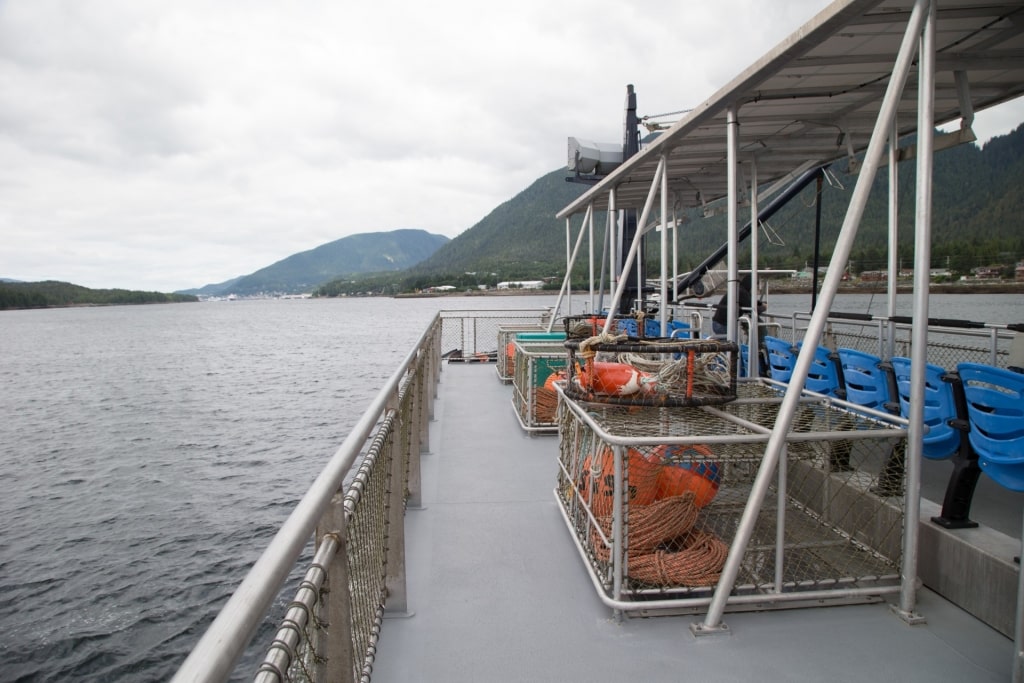
Bering Sea Crab Fishermen’s Tour, Ketchikan
Of all of Alaska’s prized wild seafood, no catch is more valuable, or dangerous to hunt, than crab. Red king crabs, which run slightly larger than their blue and gold counterparts, are still highly sought after.
These real-life sea monsters can grow to nearly six feet across and boast remarkably sweet, tasty meat. Dungeness crabs and snow crabs are also in high demand, although they tend to be smaller and are a somewhat more affordable delicacy.
For seafood lovers or anyone else fascinated by this world, the three-hour Bering Sea Crab Fishermen’s Tour is one of the best things to do in Ketchikan. Unlike many real crab-fishing expeditions, this one doesn’t involve risking life and limb—or your lunch.
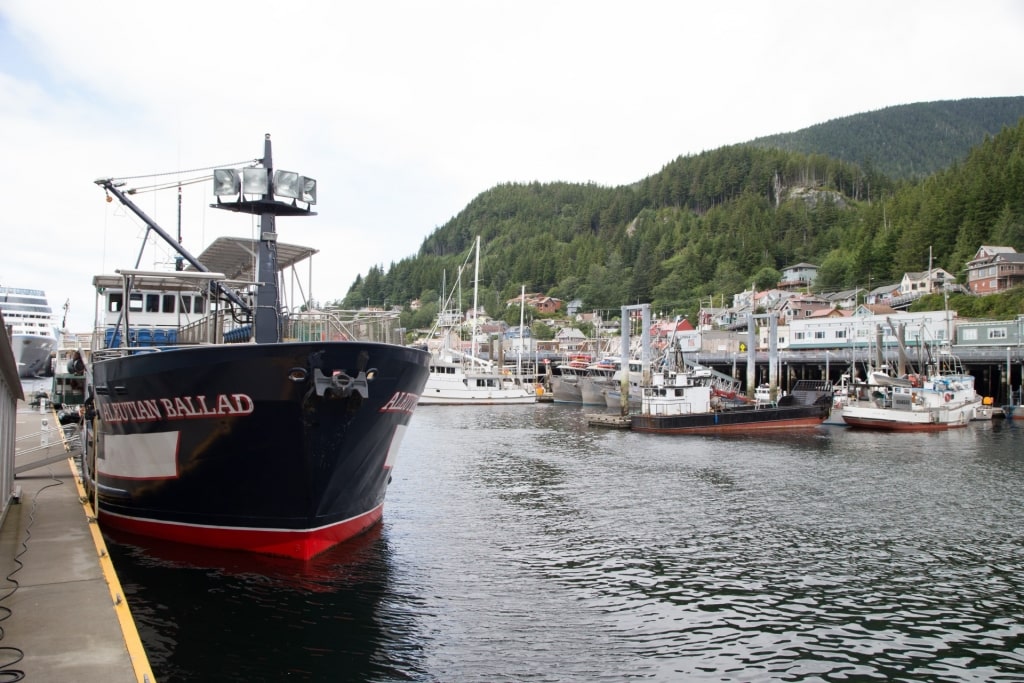
F/V Aleutian Ballad, Ketchikan
The F/V Aleutian Ballad is a sturdy, solid steel vessel measuring over 100 feet in length and it sticks to the calm waters of the Inside Passage here. Passengers can expect smooth sailing on the open-air deck.
Along the journey, you’ll see crabs of enormous size being pulled from the water. Curious passengers are even allowed to touch these giant crustaceans. More often than not, traps will pull up other sea creatures, including octopuses.
All of these other ocean critters wind up onboard in temporary holding tanks where passengers can see them up close. Before the end of the voyage, they’re released unharmed back into the sea.
Sample Craft Beers in Anchorage
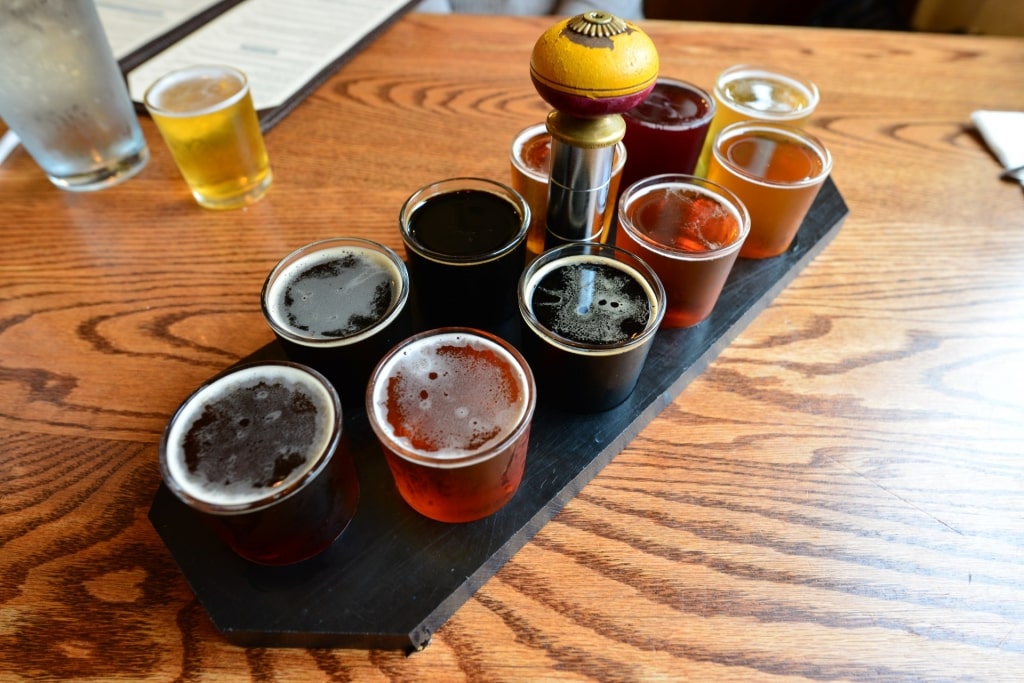
Craft beer
Alaskans tend to be known for their independence, their resourcefulness, and their refusal to adhere to convention. All of these qualities are pretty perfect for starting a craft brewery, which is perhaps why this sparsely populated state sports so many exceptional ones. The best Alaskan craft breweries take advantage of the state’s local ingredients, many of which are rare or wild.
The original here is Midnight Sun Brewing Co., which got its start back in 1995. Today, the Alaskan brewery is a well-established powerhouse with one of the best taprooms in town.
At any given time, The Loft offers 16 rotating draft beers, plus an extensive selection of bar food. The stars here are the boozy barleywines and imperial stouts. If you get a chance, try the heady Monk’s Mistress, an especially potent Belgian-style dark ale.
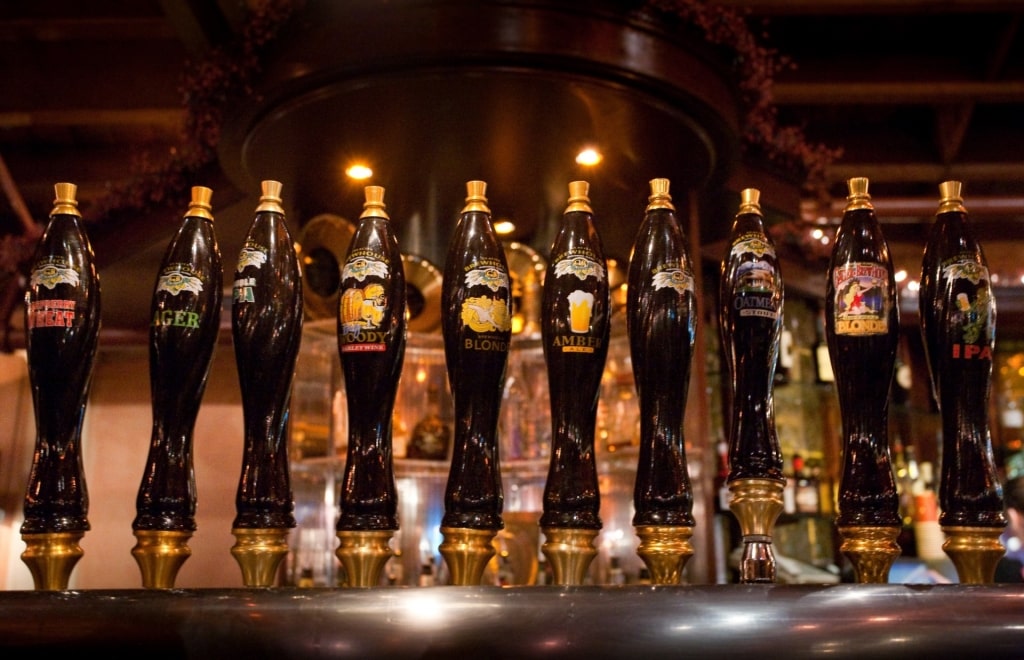
Glacier Brewhouse Photo by Anchorage Downtown Partnership on Flickr, licensed under CC BY 2.0
Glacier Brewhouse is another one worth seeking out. Opened just a year after Midnight Sun Brewing Co., the brewery is particularly proud of its barrel-aging program. The constantly rotating selection of draft beers alone is worth checking out. It doesn’t hurt, though, that the brewhouse is one of the best places to eat in Anchorage.
The high-ceilinged, woodlined restaurant and taproom has a clear view of the craft brewery. Take a seat at the bar and dine on wild Alaskan seafood and pizzas made using an Old World rye sourdough starter.
See Wolves, Moose, & Other Wildlife Up Close
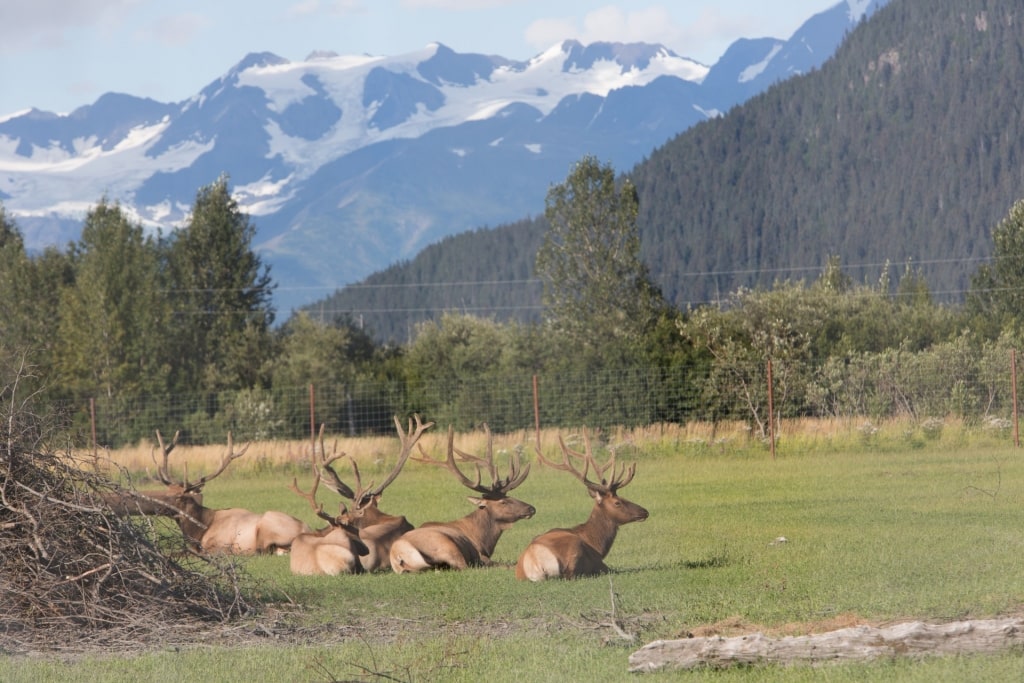
Alaska Wildlife Conservation Center
Located an hour’s drive from downtown Anchorage, the Alaska Wildlife Conservation Center is one of the best chances to see the state’s charismatic megafauna. Note that this is not a zoo. Almost all of the animals here were orphaned or severely injured and could not survive on their own in the wild.
The center allows them to live out their days in spacious enclosures that closely mimic their natural habitats. Check the schedule for regular talks and educational programming.
Kids will love meeting feathered and furred characters like Snappy, a great-horned owl with a partially amputated wing, and Hugo, a grizzly bear found abandoned more than 20 years ago. Moose, elk, reindeer, wood bison, and muskox also roam these pastures. Of particular note is the small resident wolf pack, who love playing with animal handlers.
Spy on Bears in Lake Clark National Park
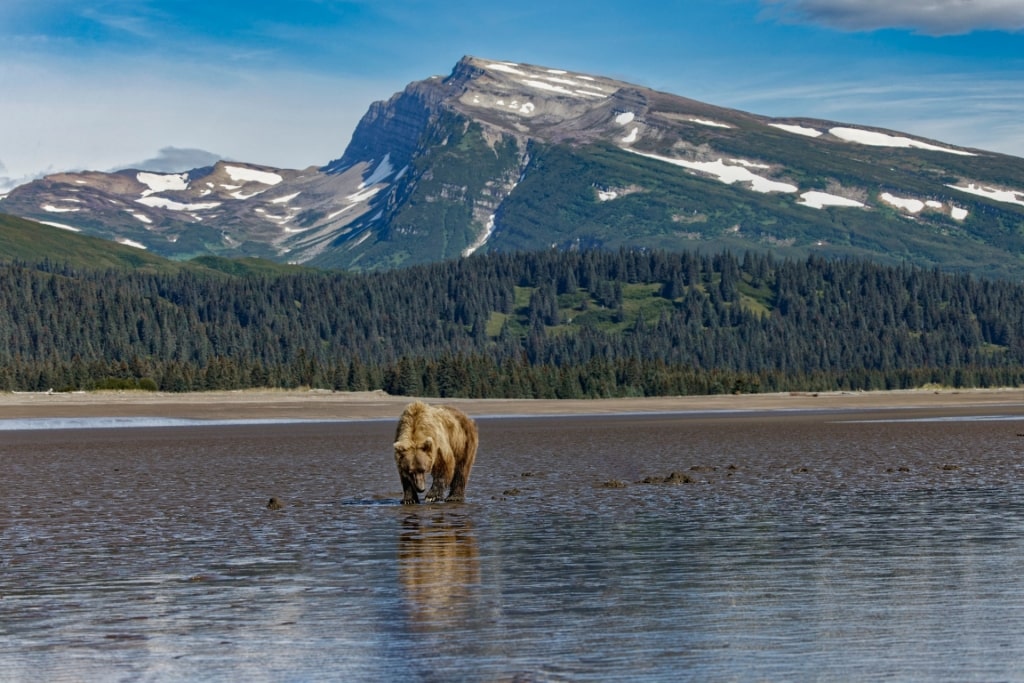
Lake Clark National Park
Alaska is known for being home to a vast array of wildlife, but perhaps none are more synonymous with the state than its bears.
The state boasts more than 140,000 of these highly intelligent mammals, including 98 percent of the American population of brown bears. For Alaskans, encounters with brown, black, and polar bears are simply a part of life.
Interestingly, brown bears and grizzly bears are the same species—the former simply inhabit coastal areas while the latter live in landlocked territory. Kodiak bears, meanwhile, are a subspecies of brown bear found exclusively in the Kodiak Archipelago. Black bears often coexist with brown bears, but are significantly smaller and usually less aggressive.
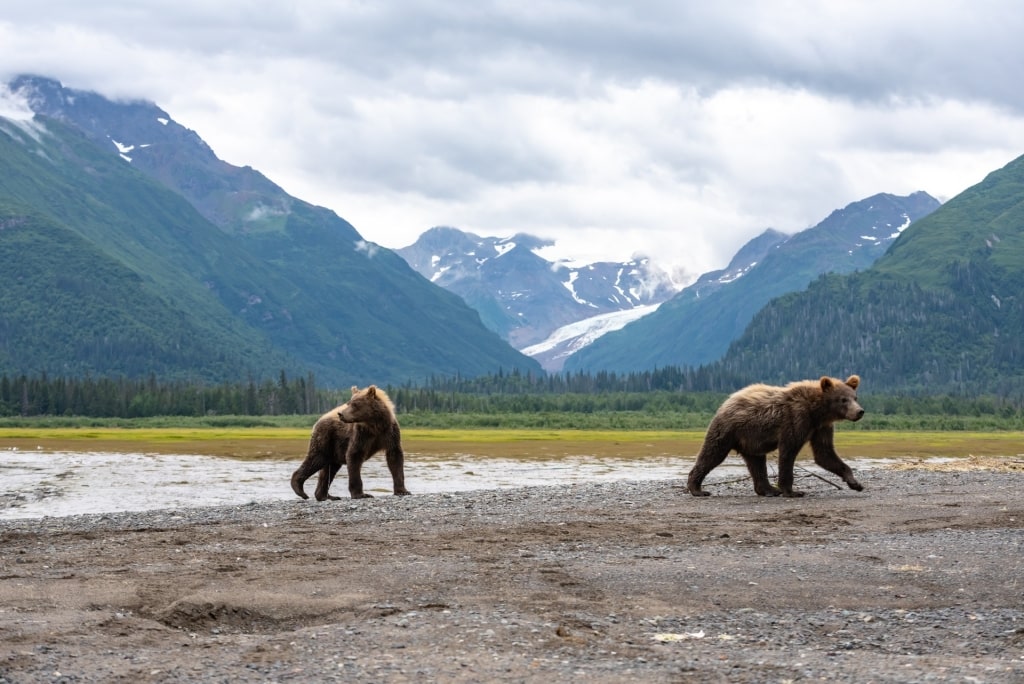
Lake Clark National Park
While travelers may very well inadvertently encounter a brown or black bear right in Anchorage, your chances are significantly higher just outside of the city. Lake Clark National Park, roughly an hour and a half drive out of town, is one of the best places to see bears in Alaska.
When snapping photos of brown or black bears, be sure to follow your guide’s safety precautions. In general, bears do not like to attack humans unless provoked. Nevertheless, these are incredibly powerful, wild animals that can run as fast as a horse.
When in bear country, either avoid carrying food or make sure it is tightly sealed. Bear cubs may look cuddly, but maintain a safe distance to avoid upsetting any protective mama bears.
Stroll Along the Homer Spit
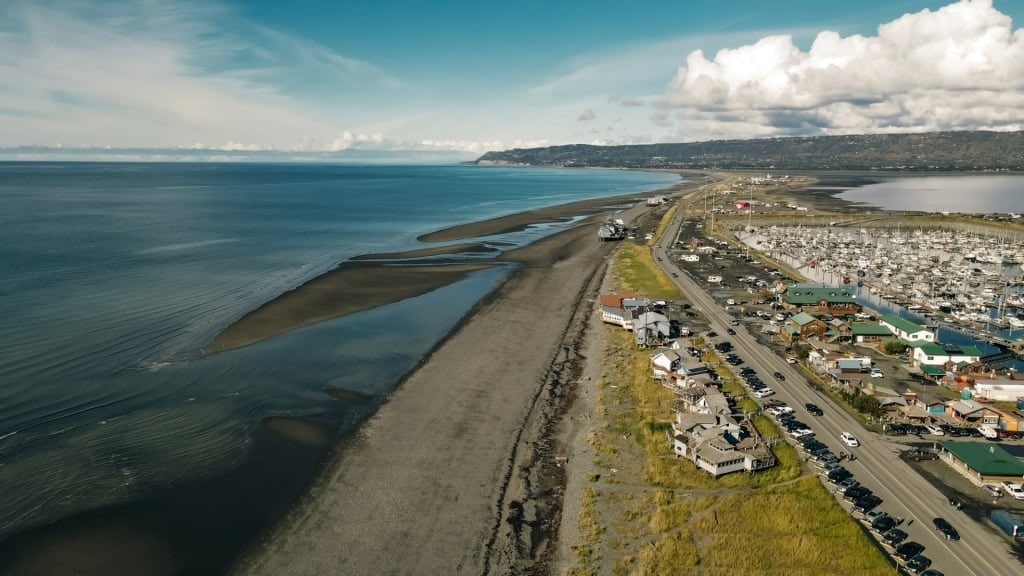
Homer Spit
Few places are more atmospheric than the Homer Spit on a gorgeous summer afternoon. This spindly peninsula stretches 4.5 miles into the icy waters of Kachemak Bay. The strip of land is so narrow that you’ll see water on both sides as you wander along the promenade.
In the backdrop, the snow-capped peaks of the Kenai Mountains loom. Overhead, birds of prey swoop and soar. Bald eagles are far more prevalent in Alaska than any of the lower 48 states and this is by far one of the best places to see them in the wild.
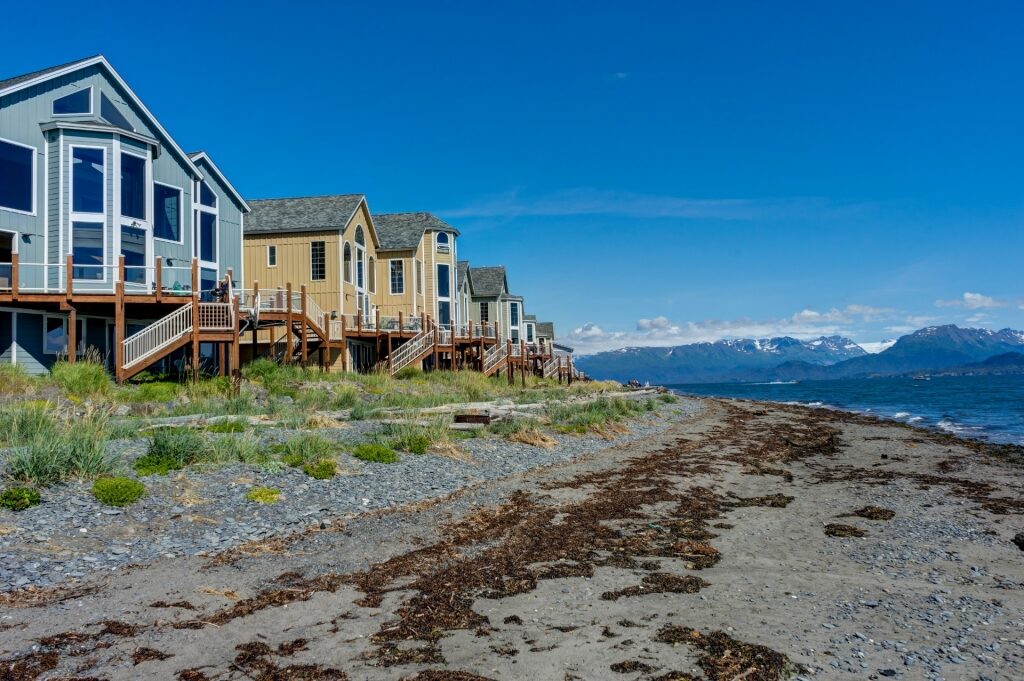
Homer Spit
As spectacular as the surrounding scenery is, exploring the Homer Spit itself is one of the best things to do in Homer. Galleries, cafés, and eateries line virtually the entire peninsula. Homer has a famously bohemian streak, thanks to the many artists who have migrated here and made a home for themselves.
After poking around the local galleries, stop for brunch at La Baleine Café. Chefs Kirsten and Mandy Dixon pride themselves in sourcing organic ingredients from the Homer Farmer’s Market.
Order a “Musher Meal,” which the duo served to participants in the Iditarod Sled Dog Race for 30 years. It’s a hearty plate of reindeer sausage, eggs, Manchego, and salsa on corn tortillas.
Walk Along a Glacier
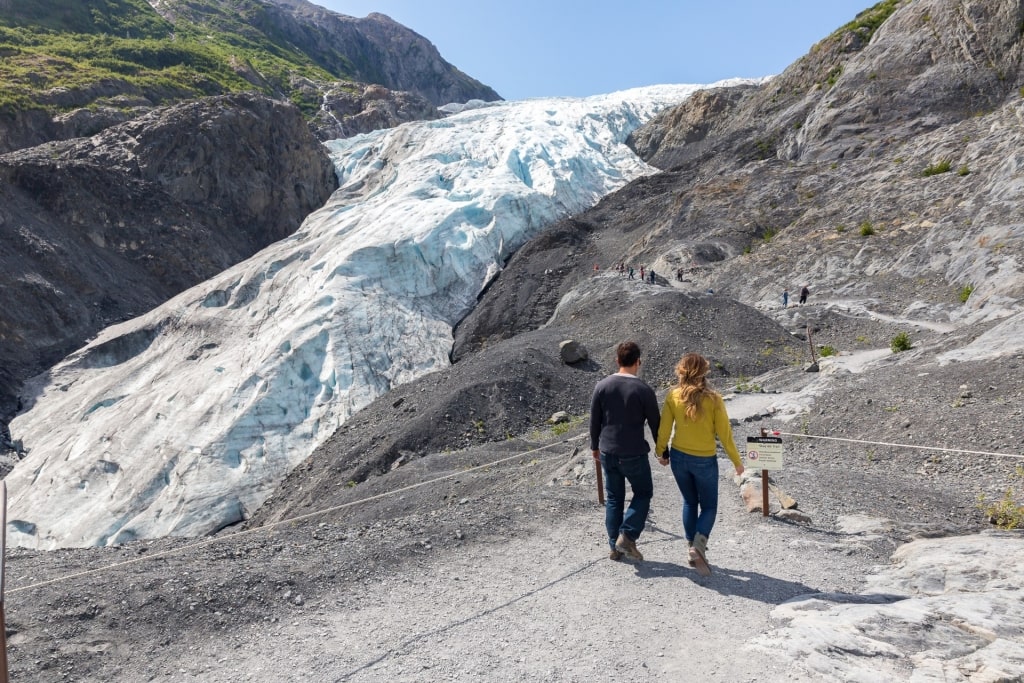
Exit Glacier, Kenai Fjords National Park
There are estimated to be around 27,000 glaciers in Alaska, but many of these are all but inaccessible to humans. Luckily, there are a few key exceptions to this rule, which are a breeze to reach.
One of the most beautiful places in Alaska, the Exit Glacier in Kenai Fjords National Park is located a mere 15-minute drive from downtown Seward.
For generations of mountaineers, this massive, flowing expanse of ice has served as an entry point to the sprawling Harding Ice Field. Yet even without technical climbing equipment, visitors can easily walk the Glacier View Loop. This well-maintained, one-mile trail offers incredible photo-ops of Exit Glacier and is manageable for all levels of hikers.
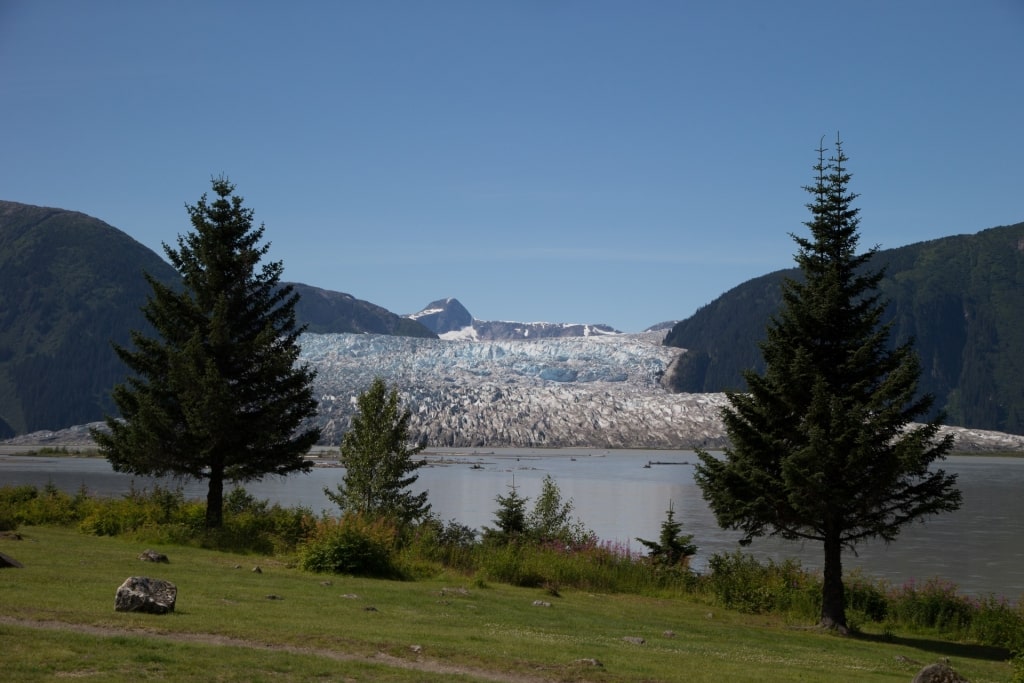
Mendenhall Glacier
Another stunning glacier that makes for an ideal afternoon trip is the 13-mile Mendenhall Glacier. Located an easy 12-mile drive from downtown Juneau, this tidewater glacier is accessible by kayak or by road. As a bonus, the visitor center goes above and beyond with top-notch exhibits.
Board the White Pass Railway
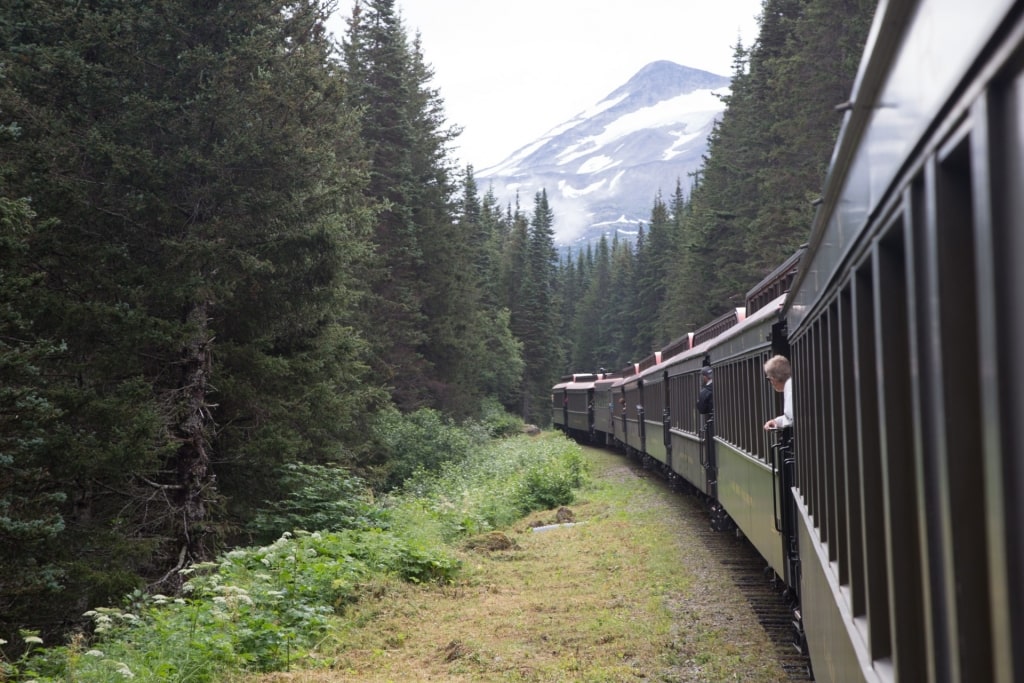
White Pass Railway
The White Pass Summit Excursion near Skagway is arguably one of the most stunning rail journeys in the world. The vintage train cars hug the sides of the mountain for virtually the entirety of the two-and-a-half hour round-trip sojourn. The views are something every visitor interested in both history and scenery must see in Alaska.
As you wind along sheer slopes, it’s hard not to think of the brave workers who risked life and limb to build the route in the first place. At the onset of the Klondike Gold Rush, the routes into Alaska’s vast interior were treacherous. Neither the Chilkoot Trail nor the White Pass Trail were safe for the tens of thousands of miners pouring into the area.
Michael J. Heney, a railroad builder with the grit and the chops to take on such a challenge, joined up with Sir Thomas Tancrede, who had investor connections. In 1898, construction on one of the most difficult rail construction projects known to man began. At one more, around 2,000 men were working here to lay track as fast as possible.
Pan for Gold in Fairbanks
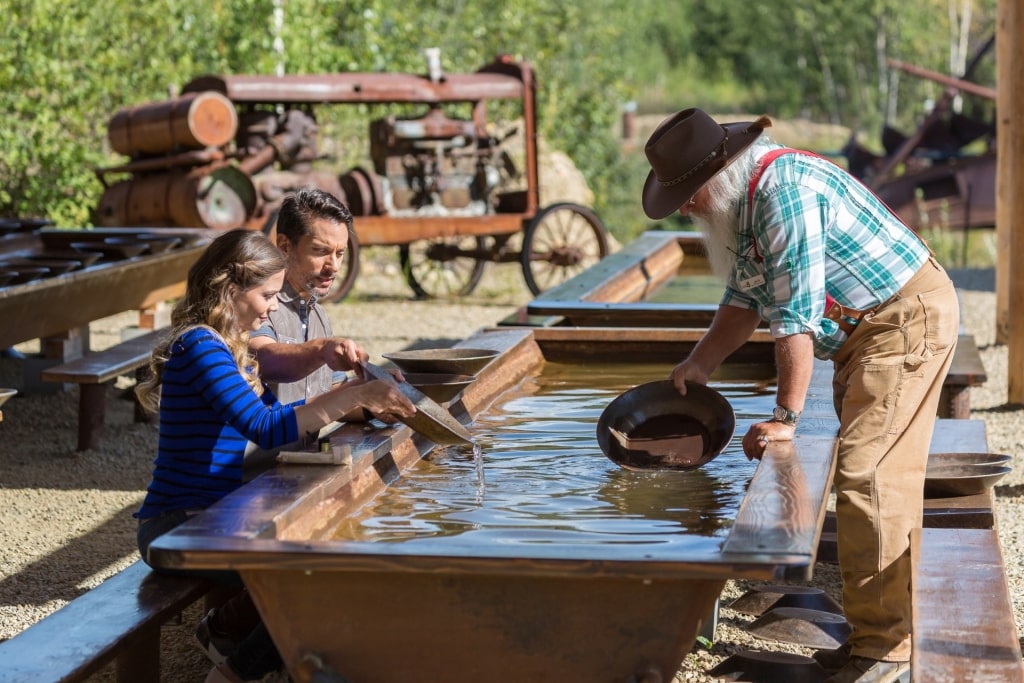
Gold panning in Gold Dredge 8, Fairbanks
Alaska’s Gold Rush history may have only lasted a little over three years, but it forever changed the state. From 1896 to 1899, more than 100,000 prospectors headed north to seek their fortune.
Many would return home penniless, while a few struck it rich. In the process, a network of boom towns sprung up to accommodate the miners. Some likened it to the Wild West, a quasi-lawless period of big dreams and grand adventures.
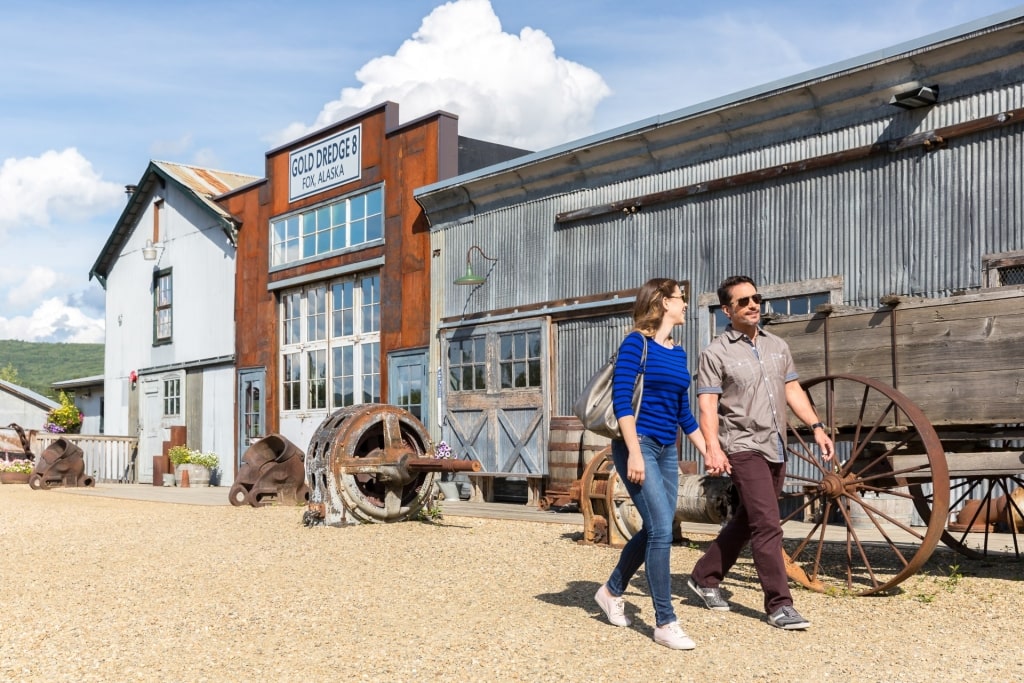
Gold Dredge 8, Fairbanks
Even after the initial fervor subsided, people continued to search for gold in these lands. The Goldstream Dredge No. 8 was a mining operation in Fairbanks from 1929 to 1959. Today, this carefully preserved historic site allows visitors to learn all about the past.
Along the way, you’ll hear true stories of the larger-than-life figures who once populated this place. At the end of the tour, visitors can even try their hand at panning for gold. More than a few have walked away with a very valuable Alaskan souvenir.
Marvel at the Tongass National Forest
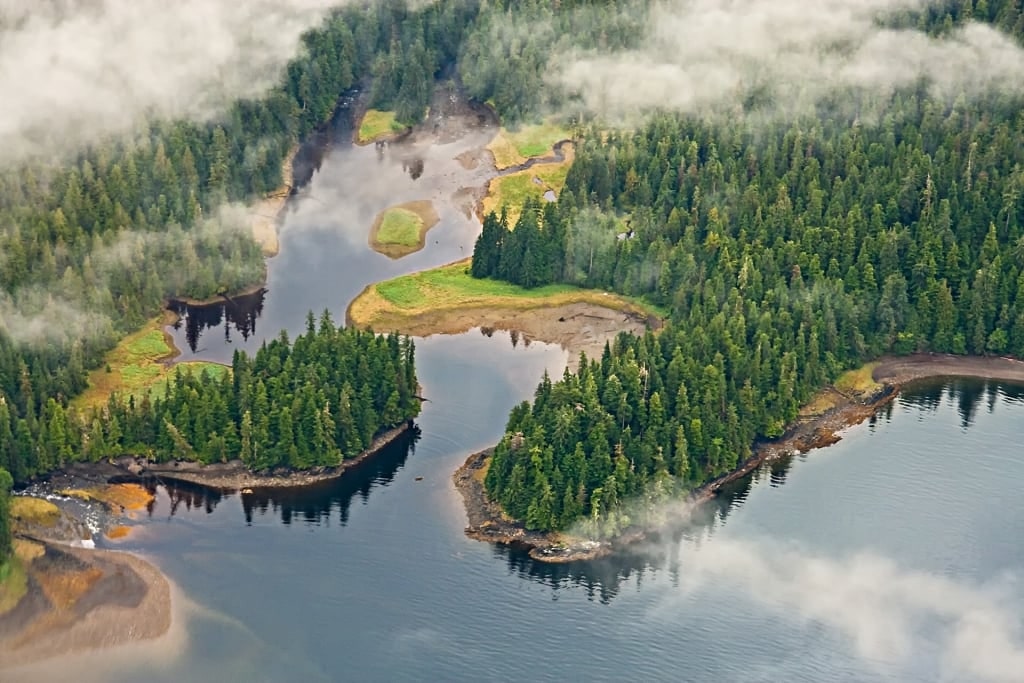
Tongass National Forest
As the largest intact temperate rainforest in the world, the Tongass National Forest is a marvel. Wandering along the hiking trails here, it’s possible to imagine a time before humans reshaped their surrounding landscape.
The rainforest covers more than 11,000 miles of Alaska’s southern coastline. Just about everything everywhere you look in here is alive. Ancient Sitka spruce, alder, hemlock, and yellow and red cedar trees form a dense, verdant canopy. Meanwhile, the forest floor is vivid green with ferns, moss, and other vegetation.
It’s possible to enter the rainforest at many points, but the trails around Juneau are particularly well-maintained.
Keep an eye out for both brown and black bears, both of which thrive here. Salmon run through the streams in season, which means there are a number of places to watch bears hunting in preparation for winter. Shy Sitka deer also regularly flash through the trees and lucky visitors may even spot a wolf.
Go Fly Fishing in Denali National Preserve
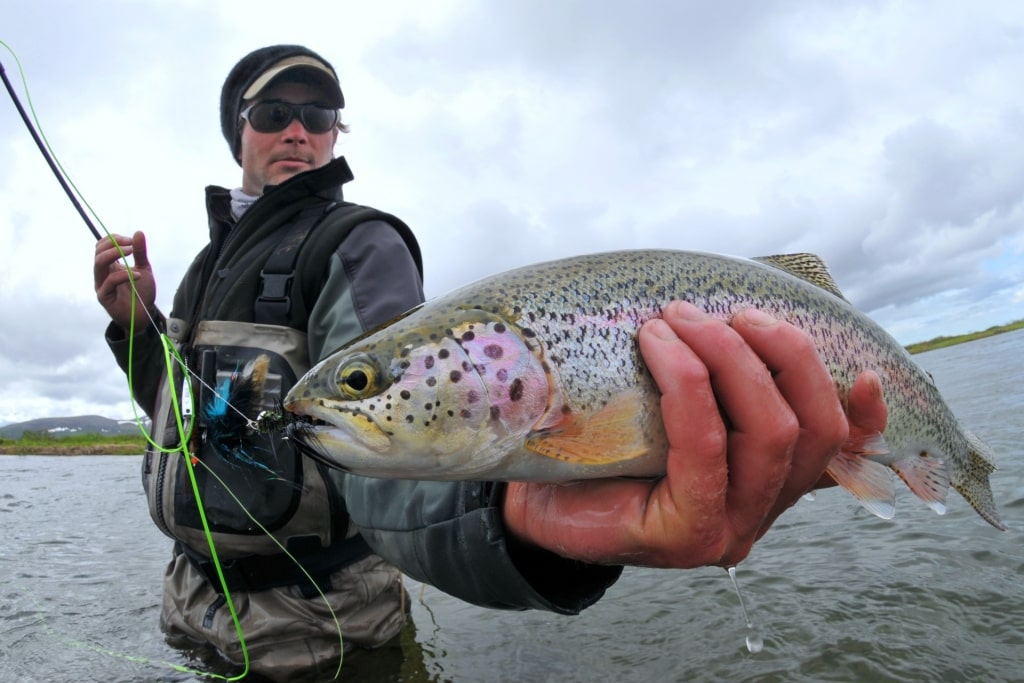
Fly fishing
Even if you’ve never tried your hand at fly fishing, Alaska is a great place to start. The state boasts pristine streams with healthy fish populations. That means that even relative novices have an excellent chance of snagging a trophy-worthy catch.
Denali National Preserve, adjacent to the Alaskan national park itself, allows for sport fishing and is a great place to start. Note that in order to go fishing, you’ll need a non-resident fishing permit. Luckily, these are easily obtainable and guides on organized fly fishing trips will typically pick one up for you.
One of the best places to fish in Alaska, travelers can expect to haul in trout and wild salmon in this area depending on the season. Fly fishing here tends to be catch-and-release—although locals can and do eat their catch. Even if you’re not planning to cook and clean your catch, you can still pose for a killer photo with it.
Learn About the History of the Alaskan First Nations
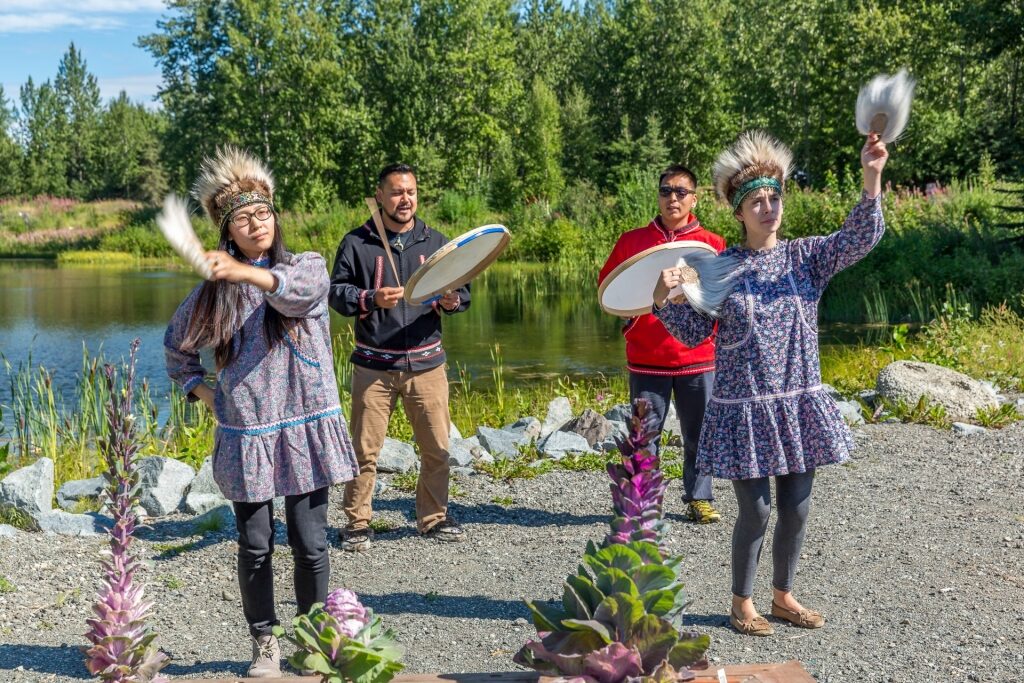
Alaska Native Heritage Center
Thousands of years before European colonists arrived on Alaskan shores, Indigenous people fished, foraged, farmed, and hunted on these lands. The languages and traditions of Alaskan First Nations are still a vital part of life in this region. More than 20 percent of the state’s population identifies as Alaska Native to this day.
There are all sorts of ways to learn more about First Nations including the Tlingit, Haida, and Tsimshian. One of the best things to do in Anchorage is to visit the Alaska Native Heritage Center, which offers insights into the sophisticated strategies Indigenous people once used to survive Alaska’s harsh climate. First opened in 1999, the center delves into the past and present of 11 distinct cultural groups.
Yet as fascinating as the history of the First Nations may be, it’s important to remember that these Alaskan cultures are evolving with each new generation. Juneau, in particular, has become a hotbed of contemporary Alaskan Indigenous art. At the city’s state-of-the-art Sealaska Heritage Arts Campus, artists reinterpret traditional crafts such as textile weaving and wood carving.
Catch a Glimpse of the Tallest Peak in North America
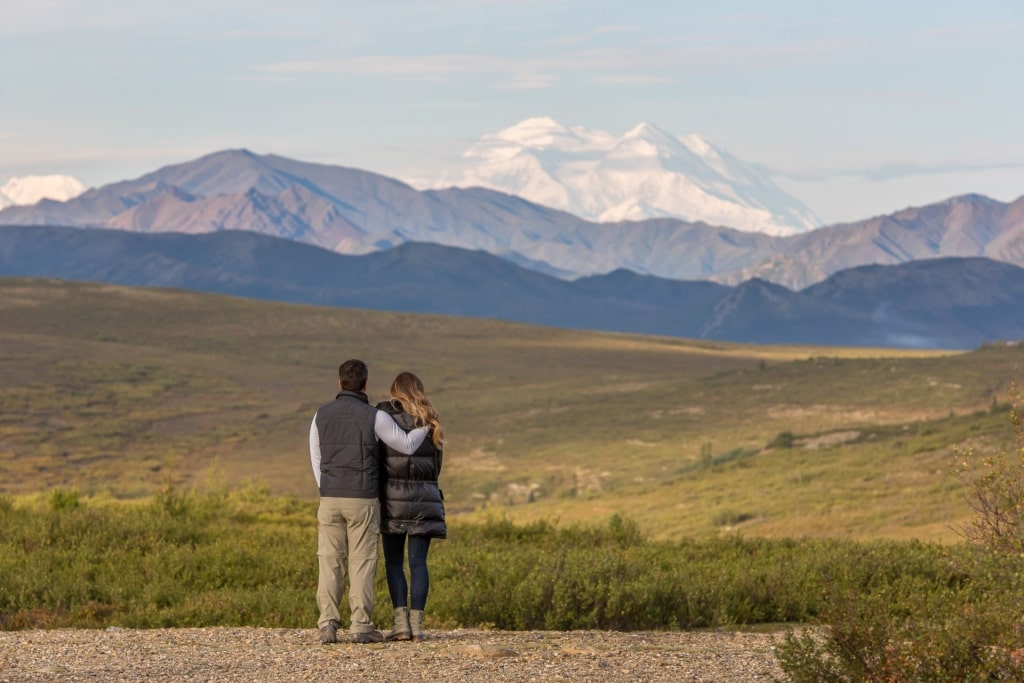
Denali National Park
Standing a staggering 20,310 feet above sea level, Mount McKinley is the highest mountain in all of North America.
“Great One” is an apt moniker for this mighty summit. The sight of its snowy summit and glaciers catching the sunlight is truly something wondrous to behold. Unfortunately, very few people can claim to have seen it. The mountain is so massive that it tends to create its own weather patterns, meaning that the summit is often veiled by clouds.
Travelers and locals fortunate enough to see the mountain in all its glory often refer to themselves as part of the “10% club”—or 30% club, depending on who asks. Either way, it’s a rare and privileged minority. Though the chances may be slim, a clear shot of this Alaskan landmark is special enough to warrant trying your luck.
See the Northern Lights From Fairbanks
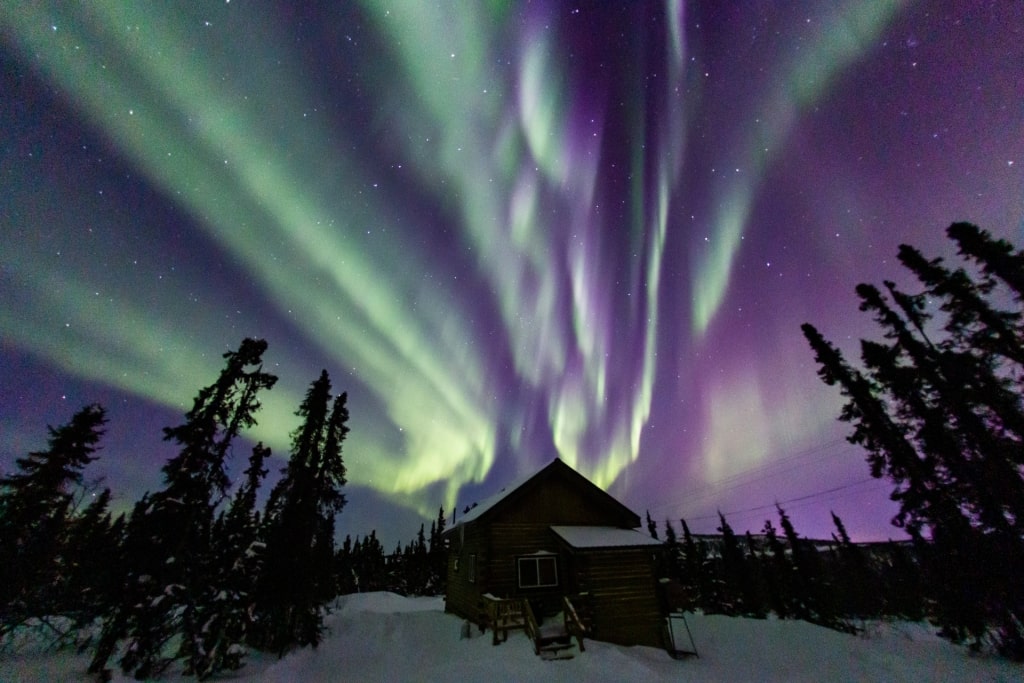
Northern Lights in Fairbanks
Witnessing the Northern Lights firsthand is one of those ubiquitous bucket list items that is very much worth doing. The aurora borealis, as it’s also known, manifests as undulating sheets of luminous violet, blue, and emerald up in the northern night sky.
Part of its allure lies in its elusive nature. Although it’s possible to monitor the conditions to find times when the probability of seeing the Northern Lights is highest, no one can predict them with complete certainty.
There may never be a guarantee of seeing the Northern Lights, but Fairbanks, Alaska, offers some of the best odds anywhere of catching this breathtaking sight. At 65 degrees north latitude, this is one of the closest bastions of civilization to the Arctic Circle.
During the late summer nights, when there is some darkness, the chances of seeing colors dance across the Milky Way are fairly high.
Ride ATVs in Denali National Park and Preserve
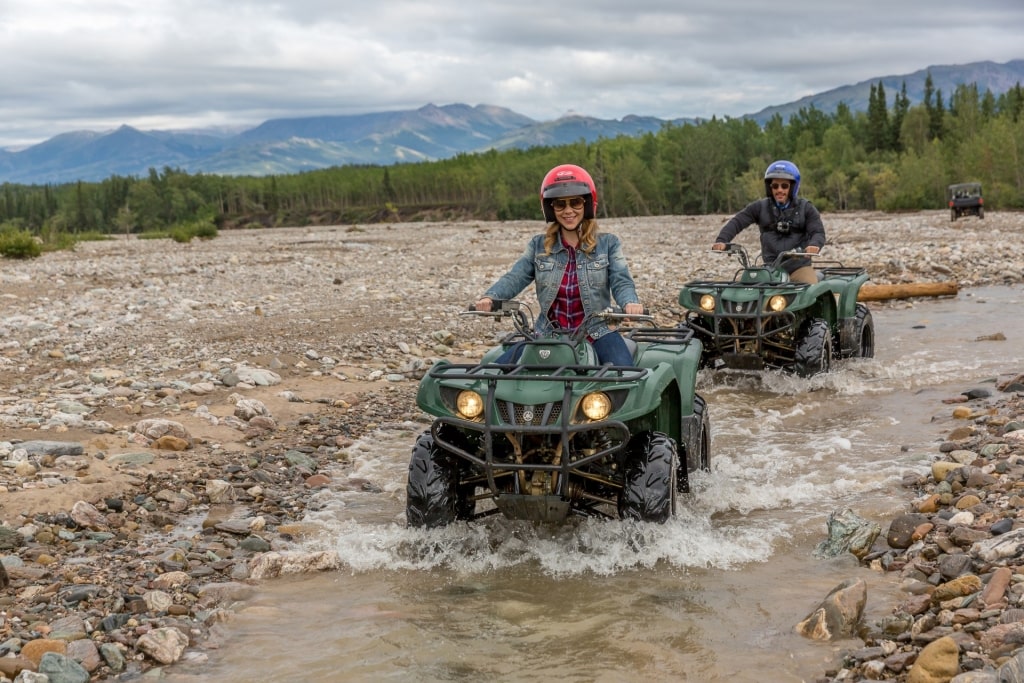
Denali National Park
Rugged, wondrous Denali National Park is one of the best places to visit in Alaska to see some of North America’s megafauna out in the wild.
The park itself is home to 169 species of birds, plus 39 species of mammals, including many of Alaska’s most iconic favorites. Both brown grizzly bears and black bears forage in these woods and fish in the park’s streams. Moose, caribou, and elk all graze here. Eagle-eyed visitors will often see herds of snow-white Dall’s sheep clambering along sheer rock faces.
The area is also one of the few places travelers have a good chance of seeing wolves in the wild. Although gray wolves can be found in many parts of North America, these intelligent predators often tend wisely to steer clear of humans. At one point, these creatures had been hunted to near extinction.
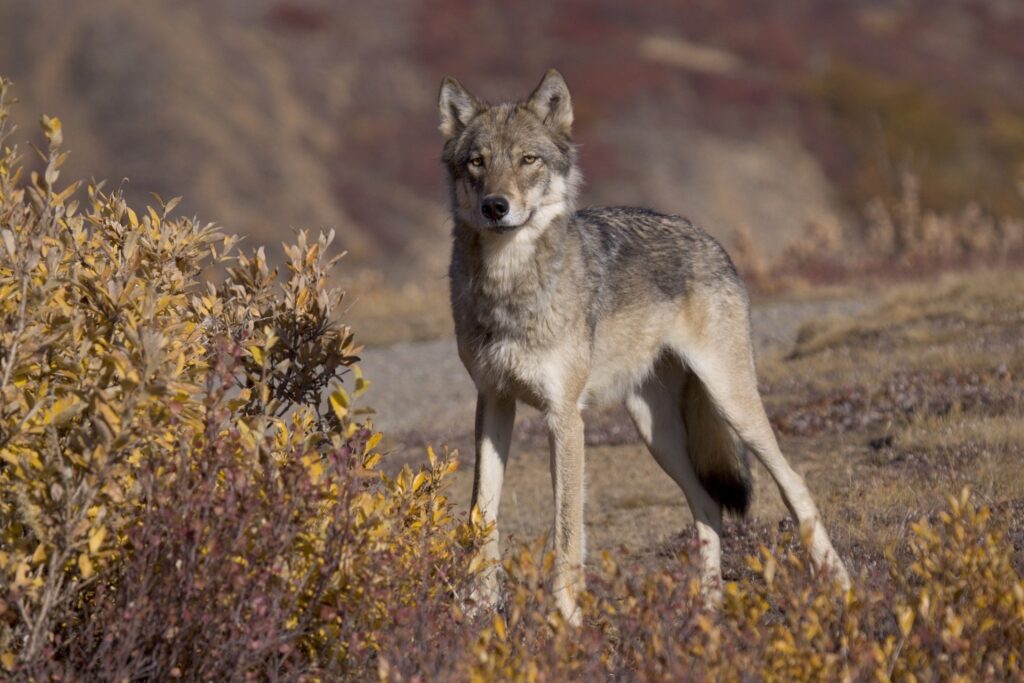
Gray wolf
The more biologists study them, the more they have come to realize how crucial wolves are to a healthy ecosystem. Denali National Park is one of the few places where the population is substantial enough that fortunate travelers might see these creatures roam.
Part of the reason wildlife thrives here is the relative lack of paved roads and other hallmarks of human civilization. That means that visitors looking to explore the national park and nearby preserve have limited transportation options. Inside the park, guided bus tours and park shuttles run along a single, winding road towards the mountain itself and back.
To get off the group bus, you’ll need a sturdy, all-terrain vehicle and an experienced guide. An ATV ride offers an unbeatable opportunity to get off the main drag and see Alaskan animals. It’s also a thrilling adventure in and of itself.
Fly to the Arctic Circle
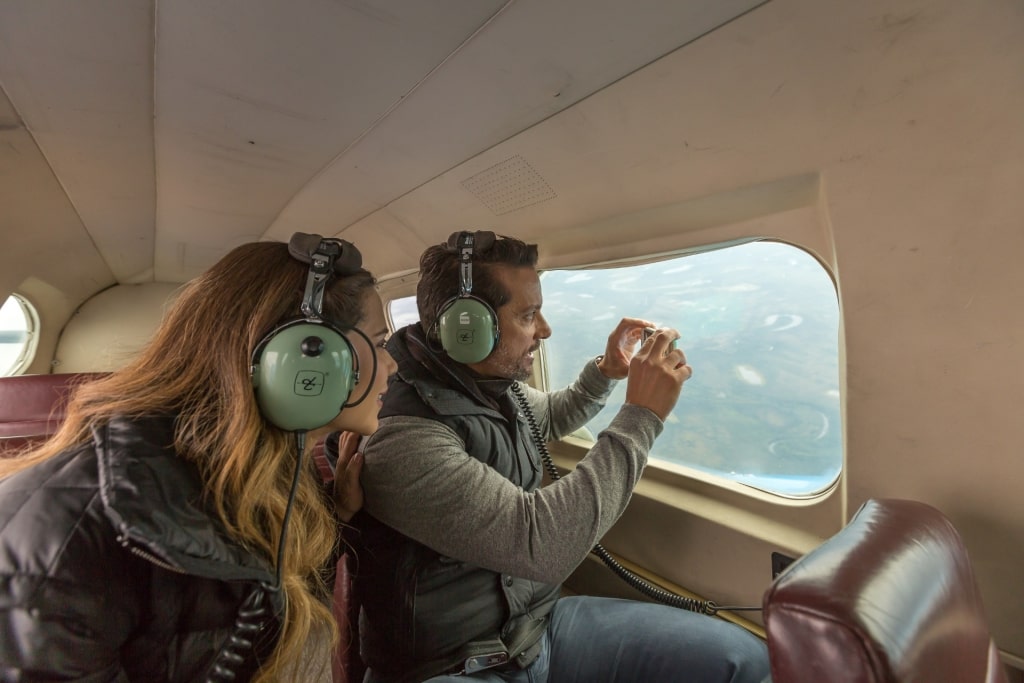
Flightseeing in Arctic Circle
The Arctic Circle is one of the most surreal places on planet Earth. This northernmost latitude is home to the midnight sun and the polar night on the summer and winter solstices. On the former, the sun never sets for 24 hours; on the latter, it never rises.
The far northern city of Fairbanks is less than 200 miles from the Arctic Circle, but the land journey is not for the faint of heart. Around 75 percent of the road there is unpaved and there are few signs of human civilization along the way.
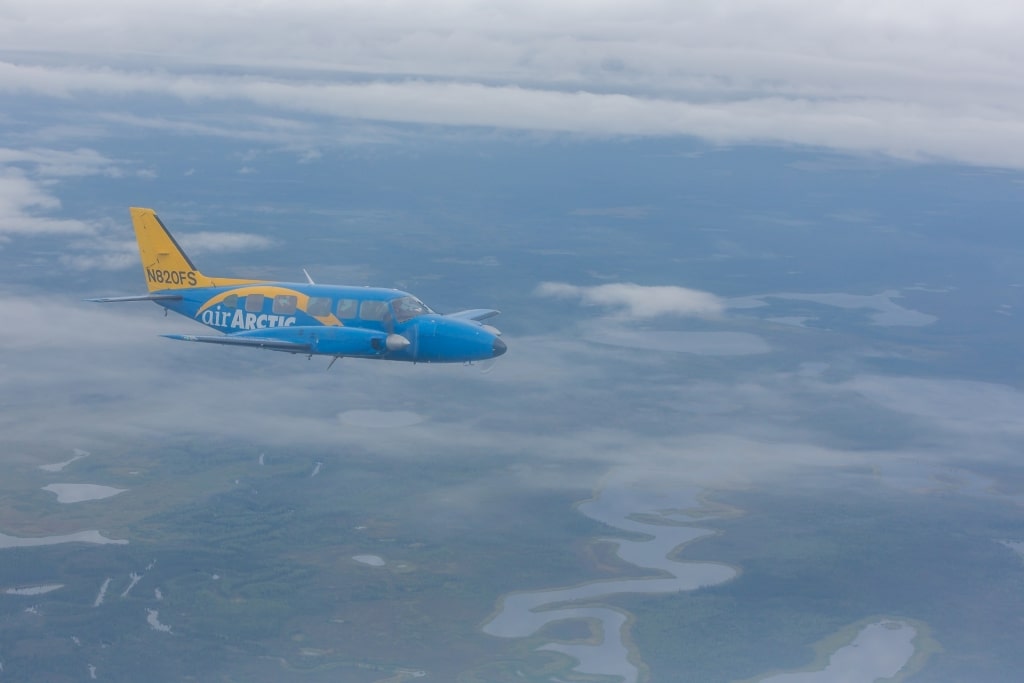
Flightseeing in Arctic Circle
While intrepid travelers with camping gear still make the trek, travelers who are pressed for time may wish to opt for a faster and far more scenic route. Flightseeing is one of the best things to do in Alaska, and round-trip flights from Fairbanks can whisk passengers to the Arctic Circle and the Brooks Mountain Range in a matter of hours.
Along the way, you’ll see the Yukon River glinting majestically in the sun, not to mention miles and miles of some of the last true remaining wilderness.
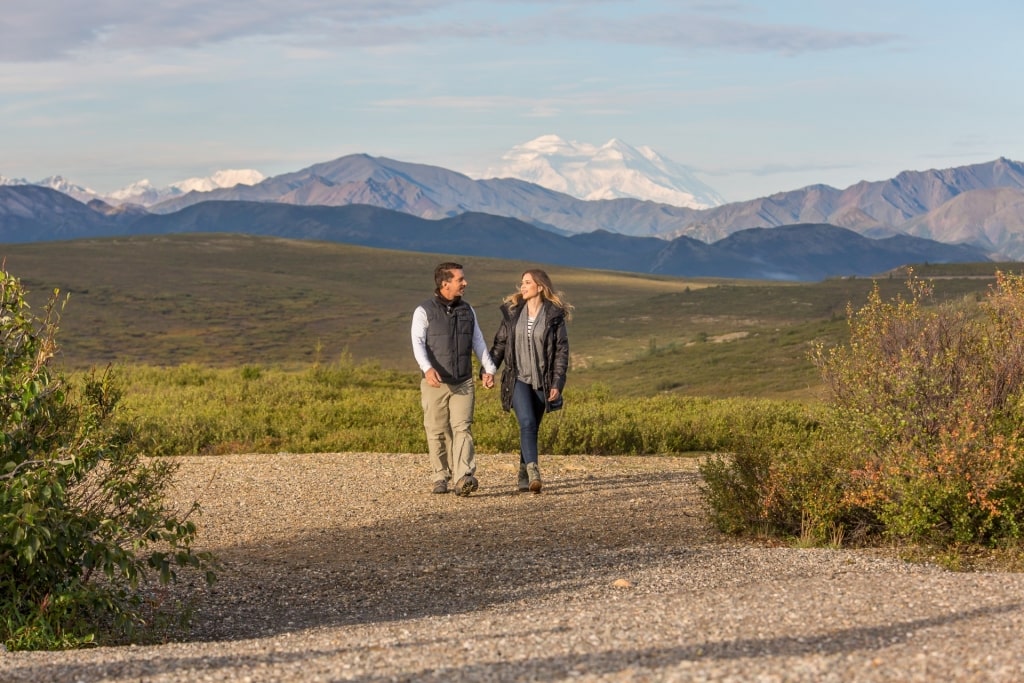
Denali National Park
There’s simply no better way to experience all the wonder of the Last Frontier than aboard a cruise with Celebrity. Browse our upcoming Alaska cruises and book your next great adventure today.
